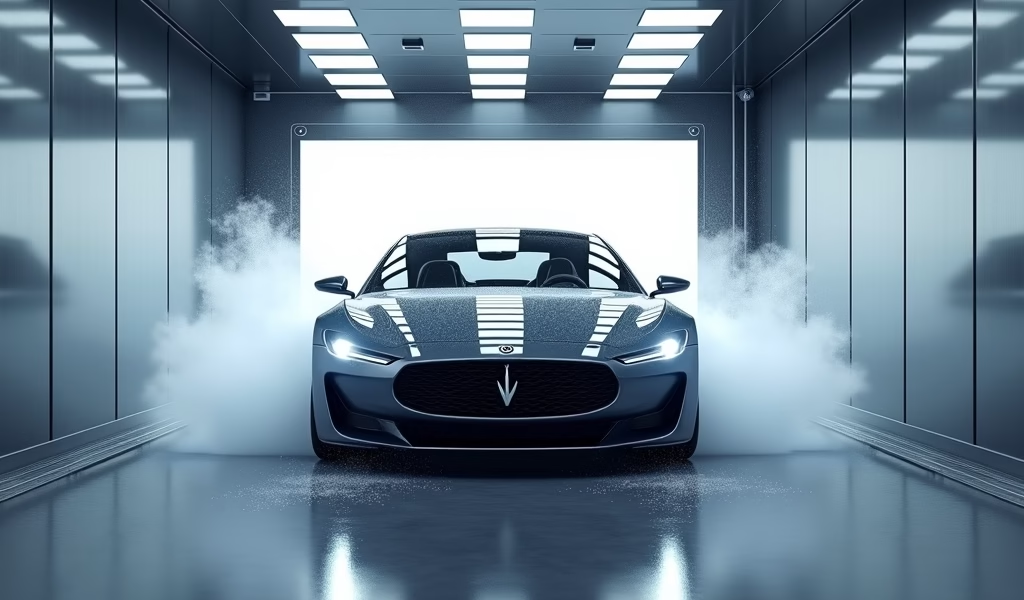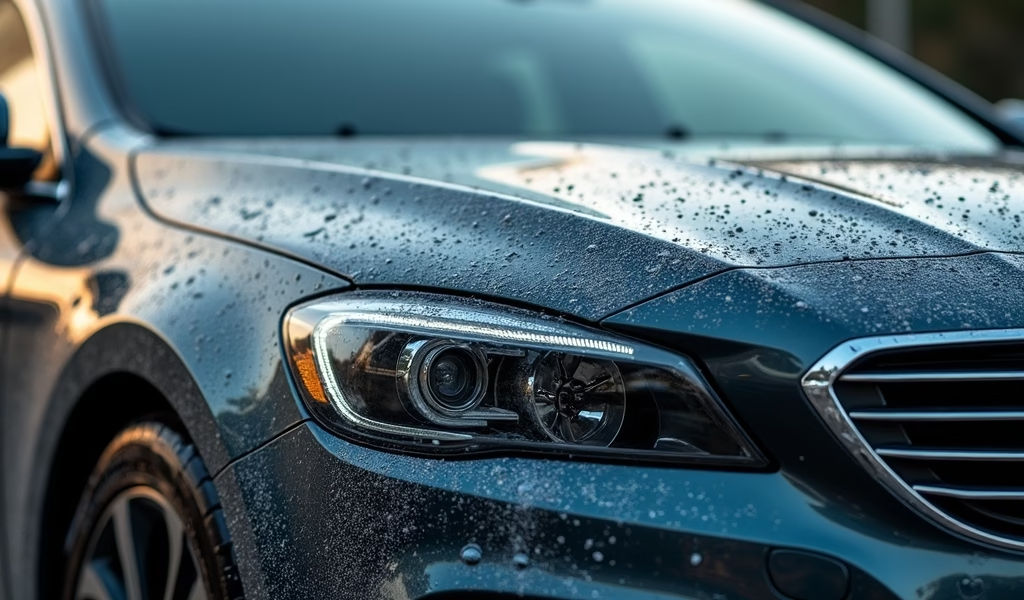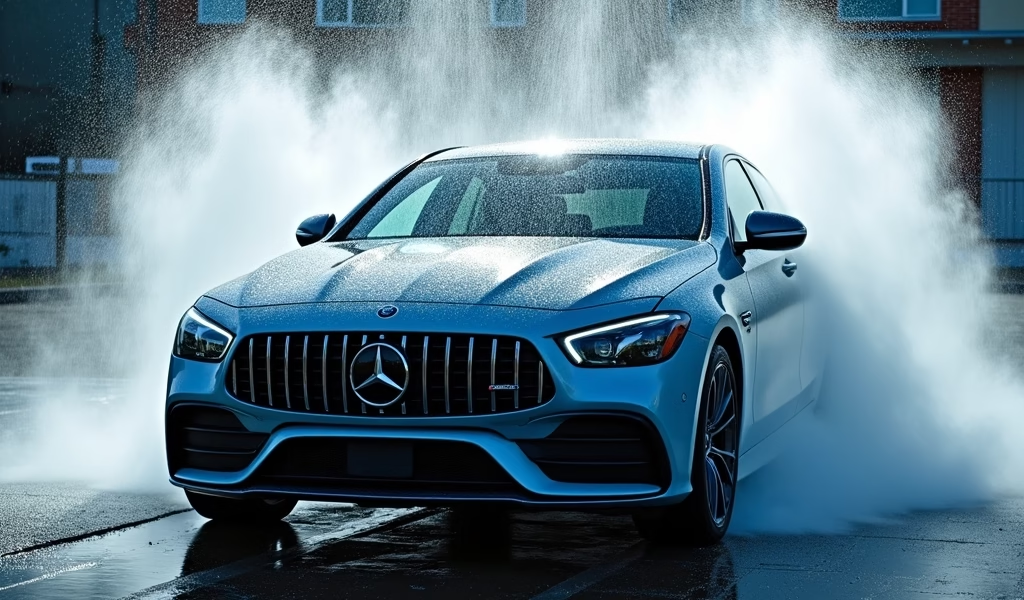Overview
Touchless car washes use high-pressure water jets and specialized detergents to clean vehicles without physical contact, offering superior paint protection while avoiding the scratches common with traditional brush systems. This guide covers the complete process—from preparation and choosing the right wash program to proper positioning, during-wash considerations, and post-wash care—while explaining the environmental impact and benefits of touchless washing for preserving your vehicle’s finish.
Table of Contents
- What is a Touchless Car Wash?
- Benefits of Using a Touchless Car Wash
- Step 1: Proper Preparation Before the Touchless Wash
- Step 2: Choosing the Right Touchless Wash Program
- Step 3: Properly Positioning Your Vehicle
- Step 4: What to Do During the Wash
- Step 5: Post-Wash Care and Maintenance
- Common Pitfalls to Avoid with Touchless Car Washes
- Environmental Impact of Touchless Car Washes
- Conclusion
- Frequently Asked Questions
What is a Touchless Car Wash?
A touchless car wash is like a gentle rain shower for your vehicle – only with precision and purpose. Unlike traditional brush systems that can feel like sending your prized possession through a mechanical octopus, touchless systems use a combination of high-pressure water jets and specialized detergents to clean your car without physical contact. As a mechanic with over 15 years in the field, I’ve seen how these systems have evolved to become both gentler on paint and more effective at removing stubborn grime.
The technology behind touchless car washes has come a long way since their introduction in the late 1990s. Modern systems use sensors that map your vehicle’s contours like a tailor measuring for a bespoke suit, ensuring that every nook and cranny receives proper attention. According to recent industry data, touchless washes now account for approximately 37% of commercial car wash operations in the United States, a figure that’s been climbing steadily as car owners become more conscious about preserving their vehicle’s finish.
The basic process involves pre-soaking, high-pressure washing, applying specific cleaning agents, rinsing, and finally drying – all without a single brush touching your vehicle’s surface. This makes touchless washes particularly valuable for newer vehicles or those with specialty finishes that might be vulnerable to the smallest scratches.
Benefits of Using a Touchless Car Wash
Opting for a touchless car wash is like choosing a surgical scalpel over a butter knife – it’s all about precision and care. The most significant advantage is paint protection. Traditional brush washes, even with modern materials, can harbor minute particles of dirt from previous vehicles, turning them into thousands of tiny scratching agents. Touchless systems eliminate this risk entirely.
For vehicles with specialized features, the benefits multiply exponentially. Those stylish antenna mounts, roof racks, and delicate spoilers that make your car stand out in a parking lot like a peacock among pigeons are much safer in a touchless environment. The specialized detergents used are typically formulated to be gentle yet effective, breaking down road grime without attacking your car’s protective clear coat.
From a time perspective, touchless washes typically complete a full cycle in 5-7 minutes – comparable to automated brush systems but with none of the anxiety about potential scratches. And for those keeping track of their environmental footprint, many modern touchless facilities boast water recycling systems that reuse up to 80% of their water, making them surprisingly eco-friendly despite their high-pressure approach.
Regular touchless washing can extend your paint’s life by years. Professional detailers often note that vehicles maintained primarily through touchless systems show significantly less “wash marring” – those fine spider-web scratches that diminish a car’s shine over time. For those of us who see our vehicles as more than just transportation, that preservation of beauty is worth every penny.

Step 1: Proper Preparation Before the Touchless Wash
Preparing your vehicle for a touchless car wash is like setting the stage for a performance – it makes all the difference in the final result. Start by checking your vehicle for any loose items that could be dislodged by high-pressure water. Those aftermarket antenna toppers, magnetic signs, or partially attached trim pieces won’t stand a chance against pressurized jets that can reach up to 1,000 PSI.
Timing matters more than most realize. If you’ve recently applied wax or ceramic coating, give it at least 7 days to fully cure before introducing it to the powerful detergents used in touchless systems. Many premium coatings need this settling period to form proper molecular bonds with your paint – rushing this process is like pulling a cake from the oven before it’s fully baked.
For vehicles with excessive mud or debris, consider a preliminary rinse at home. While touchless systems are remarkably effective, they work best when not overwhelmed by caked-on material. A quick spray with your garden hose can remove the heaviest soil and allow the car wash to focus on the finer cleaning that it excels at. This approach is part of a sound car maintenance checklist that protects your investment.
Check your weather app before heading out. Freezing temperatures can cause doors and locks to seize after washing, turning your clean car into an inaccessible ice sculpture. Ideally, choose a day above 40°F (4°C) with enough driving time afterward to allow proper drying. This small bit of planning prevents those frustrating frozen door moments that seem to happen exclusively when you’re running late.
Step 2: Choosing the Right Touchless Wash Program
Selecting the appropriate touchless wash program is like choosing the right tool from a mechanic’s toolbox – specificity matters. Most facilities offer tiered options ranging from basic to premium, but understanding what each actually delivers will save you both money and disappointment. Basic washes typically include pre-soak, high-pressure wash, and a forced-air dry – perfect for weekly maintenance on a vehicle that isn’t heavily soiled.
Mid-tier options usually add underbody cleaning and protective wax. The underbody spray is worth its weight in gold during winter months when road salt clings to your chassis like barnacles on a ship’s hull. According to the National Association of Corrosion Engineers, vehicles in heavy salt-use areas can experience accelerated corrosion that reduces vehicle life by nearly 30% – making this option particularly valuable.
Premium packages include extras like tire shine, extended drying time, and sometimes specialized protective coatings. While the sparkly tire finish might seem purely cosmetic, quality tire treatments actually contain UV protectants that prevent rubber degradation and premature cracking. For vehicles you plan to keep long-term, these seemingly superficial additions contribute to overall longevity.
Consider your vehicle’s specific needs when choosing. A daily driver in an urban environment accumulates different contaminants than a weekend adventure vehicle. City cars battle pollution and bird droppings, while off-road vehicles contend with mud and organic matter. Urban dwellers might prioritize packages with enhanced spot-free rinse technology, while adventure seekers should lean toward options with better underbody cleaning capabilities.
Step 3: Properly Positioning Your Vehicle
Positioning your vehicle correctly in a touchless car wash is as crucial as proper alignment on your vehicle’s wheels – get it wrong, and the entire process suffers. Most modern touchless systems use guiding lights or screens to help drivers find the sweet spot, but understanding the principles behind proper positioning elevates your results from good to exceptional.
Center your vehicle on the track or markers with the precision of a surgeon. Even slight misalignment can leave certain areas under-cleaned, particularly on larger vehicles or those with unique profiles. Most systems are calibrated for average-sized vehicles, so drivers of particularly large trucks or compact sports cars should pay extra attention to positioning cues.
Proper tire placement is non-negotiable. The wash system uses your tire position to determine where your vehicle begins and ends. Roll forward until the system signals you to stop, then shift into neutral (or park for automatic transmissions) and release the brake if instructed. This seemingly simple step is often rushed, resulting in cleaning patterns that miss sections of your vehicle.
For vehicles with aftermarket modifications like lowered suspensions or wide-body kits, extra caution is warranted. These modifications can confuse automatic sensors, potentially leading to spray patterns that aren’t optimized for your vehicle’s unique dimensions. In these cases, consider speaking with the attendant before entering – most locations can make minor adjustments to accommodate non-standard vehicles and ensure you’re getting the thorough clean your pride and joy deserves.
Step 4: What to Do During the Wash

Once the touchless wash begins, your vehicle transforms into the star of a mechanical ballet – jets of water and specialized solutions orchestrating a thorough cleansing. During this performance, your role as the driver might seem passive, but there are still important considerations to ensure optimal results and prevent any unexpected issues.
First and foremost: remain calm when those high-pressure jets hit your vehicle. The initial spray can sound like a small thunderstorm has enveloped your car, but this is precisely what’s needed to lift dirt without physical contact. Modern vehicles are built to withstand significantly greater pressures than any car wash delivers – what sounds intimidating is actually well within your vehicle’s design tolerances.
Keep all windows completely closed and double-check that sunroofs and convertible tops are properly secured. While this seems obvious, professional auto technicians regularly see water damage from partially opened windows during automated washes. The pressurized water can find even the smallest opening with unerring accuracy, like water finding its way through the proverbial crack in the dam.
Turn off automatic wipers if your vehicle has rain-sensing technology. These systems can interpret the wash water as rainfall and activate unexpectedly, potentially damaging both your wiper blades and arms. Similarly, folding in power mirrors (if your vehicle offers this feature) provides added protection against the most intensive cleaning phases.
Resist the temptation to exit the vehicle or open doors if something seems amiss. Modern touchless systems have multiple safety features and emergency stops. If you have concerns, most facilities provide emergency buttons or attendants who can halt the process safely. Attempting to exit during operation is like jumping from a moving vehicle – unnecessarily dangerous and likely to cause more problems than it solves.
Step 5: Post-Wash Care and Maintenance
The moments immediately following a touchless car wash are golden opportunities to enhance and extend the cleaning benefits, much like how a proper cool-down prevents engine damage after hard driving. As you exit the wash bay, your vehicle’s surface is in an ideal state for additional protection and finishing touches that can extend that fresh-washed look from days to weeks.
Drive slowly for the first quarter-mile after washing, allowing any remaining water to naturally sheet off rather than collecting in spots. This gentle movement works like a natural air-knife, removing droplets before they can form hard water deposits. For best results, avoid immediately parking in direct sunlight, which can “bake” water spots onto your finish before evaporation is complete.
Consider keeping microfiber towels in your vehicle for quick touch-ups. Even the best drying systems can leave moisture in crevices around emblems, mirrors, and door handles. A gentle hand-drying of these areas takes just seconds but prevents annoying drip marks that can emerge minutes (or sometimes hours) after you’ve left the facility. Quality microfiber material is gentle enough to use on freshly washed surfaces without introducing scratches.
For those seeking showroom-quality results, follow your touchless wash with a spray detailer or quick wax. These products work best on a freshly cleaned, slightly damp surface – precisely what you have after a touchless wash. Modern quick detailers require minimal effort (spray and wipe) yet provide remarkable enhancement to gloss and protection. This additional five-minute investment can double the effective cleaning duration from your wash.
Establish a regular washing schedule based on your local conditions. Urban environments typically require more frequent cleaning due to increased pollutants, while coastal areas need special attention because of salt air exposure. Most vehicles benefit from touchless washing every 1-2 weeks, with the frequency adjusted seasonally. Winter often demands more frequent cleaning in regions where road salt is used, while pollen season might necessitate additional washes for allergy sufferers.
Common Pitfalls to Avoid with Touchless Car Washes
Even the best touchless car wash systems have limitations, and understanding these potential pitfalls is like knowing where the potholes are on your daily commute – awareness helps you avoid unnecessary damage. The most common misconception is that touchless systems can remove all contaminants. While remarkably effective, certain substances like tree sap, industrial fallout, and deeply embedded brake dust often require specialized treatment beyond what high-pressure water alone can accomplish.
Avoid the temptation of excessive frequency, particularly with vehicles that have aging clear coats or compromised paint. The powerful detergents used in touchless systems are designed to break down road grime quickly, but these same chemicals can accelerate deterioration of already weakened protective layers. For vehicles with paint older than 10 years, limiting touchless washes to once every two weeks and supplementing with gentle hand washing can extend finish life significantly.
Be wary of “unlimited wash” memberships unless you genuinely need frequent cleaning. While economically attractive, these programs can tempt owners into washing more often than necessary. Each wash, even touchless, creates some level of stress on exterior components. The value equation changes dramatically if you’re subjecting your vehicle to daily washes that provide minimal incremental benefit while potentially accelerating wear on trim, seals, and finishes.
Finally, recognize that even the best touchless wash shouldn’t completely replace occasional professional detailing. Think of touchless washes as daily tooth brushing and professional detailing as your dental checkup – both are necessary for optimal long-term results. Professional detailers can address issues that automated systems cannot, like removing embedded contaminants, rejuvenating oxidized paint, and applying longer-lasting protective treatments that maintain your vehicle’s value and appearance for years to come.
Environmental Impact of Touchless Car Washes
The environmental footprint of touchless car washes presents a fascinating paradox – they simultaneously use more resources per wash but often result in less overall environmental impact than alternatives. Commercial touchless systems typically use between 35-85 gallons of water per vehicle, considerably more than modern brush systems. However, this comparison tells only part of the ecological story.
Most professional touchless facilities now employ sophisticated water reclamation systems that capture, filter, and reuse up to 80% of their water. This closed-loop approach dramatically reduces their effective consumption. By contrast, a typical driveway wash at home can use 80-140 gallons, with all runoff – including oils, detergents, and contaminants – flowing directly into storm drains and eventually into local waterways untreated.
The chemical formulations used in touchless systems have also evolved significantly. Many facilities now utilize biodegradable detergents that break down naturally after use. Advanced facilities are increasingly adopting environmentally certified cleaning solutions that minimize aquatic toxicity while maintaining cleaning effectiveness. This represents a substantial improvement over traditional harsh detergents that could persist in ecosystems for months or years.
Energy consumption remains an area for continued improvement. The high-pressure systems require significant electricity to operate, though many newer installations incorporate energy recovery systems and variable frequency drives that reduce consumption by 15-30% compared to older models. Some forward-thinking operations have begun implementing solar panels to offset their considerable energy requirements, creating a more sustainable operational model for an inherently resource-intensive process.
Conclusion
Touchless car washing represents the perfect marriage between convenience and care – delivering thorough cleaning without the anxiety of potential brush-induced damage. By following the five proven steps outlined in this guide, you’ll maximize the benefits while avoiding the common pitfalls that can diminish results.
Remember that preparation sets the stage for success, proper positioning ensures complete coverage, and post-wash care extends the benefits significantly. The right program selection makes a substantial difference in both immediate results and long-term protection, especially during challenging seasonal conditions.
While no cleaning method is perfect for every situation, touchless washing offers an exceptional balance for most drivers – particularly those with newer vehicles or specialty finishes. The technology continues to evolve, with improvements in water efficiency, environmental impact, and cleaning effectiveness arriving regularly.
Ultimately, your vehicle represents both a significant investment and a daily companion. Treating it to regular touchless washing, supplemented with occasional professional detailing, ensures it remains not just clean but protected against the elements that continuously threaten its appearance and integrity. Your car deserves nothing less than this thoughtful, systematic approach to maintenance – and the pride you’ll feel driving a properly maintained vehicle makes every effort worthwhile.
Frequently Asked Questions
Is a touchless car wash safe for ceramic coatings and paint protection films?
Yes, touchless car washes are generally safe for ceramic coatings and PPF. They’re actually preferred over brush washes as they don’t create physical contact that could potentially damage these protective layers.
How often should I use a touchless car wash?
For most vehicles in average conditions, once every 1-2 weeks is ideal. Adjust frequency based on your local environment, increasing during winter in salt-heavy regions or during pollen season.
Can touchless car washes remove heavy mud and off-road debris?
Touchless washes can handle light to moderate mud but may struggle with heavy, caked-on debris. Pre-rinse very dirty vehicles with a garden hose before visiting a touchless wash for best results.
Are touchless car washes worth the extra cost compared to traditional washes?
For vehicles with quality paint finishes, the extra cost is justified by the reduced risk of swirl marks and scratches. The investment pays off in maintained resale value and extended finish life.
Will a touchless car wash remove wax from my vehicle?
Regular touchless washing will gradually reduce wax protection, but at a much slower rate than brush washes. Quality carnauba wax typically remains effective for 6-8 weeks even with weekly touchless washing.


Pingback: Best Virginia Beach Car Wash: 5 Pro Tips - knowsyourcar.com